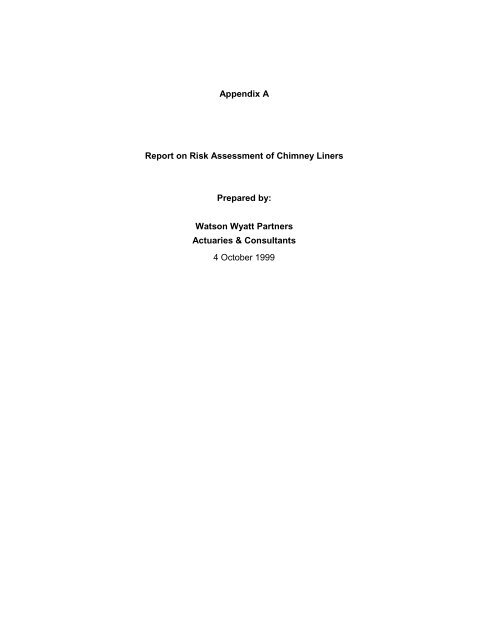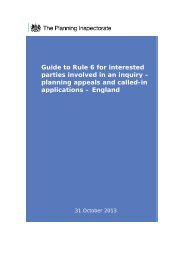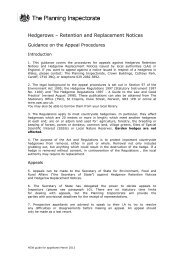Appendix A: Report on risk assessment of chimney ... - Planning Portal
Appendix A: Report on risk assessment of chimney ... - Planning Portal
Appendix A: Report on risk assessment of chimney ... - Planning Portal
Create successful ePaper yourself
Turn your PDF publications into a flip-book with our unique Google optimized e-Paper software.
<str<strong>on</strong>g>Appendix</str<strong>on</strong>g> A<str<strong>on</strong>g>Report</str<strong>on</strong>g> <strong>on</strong> Risk Assessment <strong>of</strong> Chimney LinersPrepared by:Wats<strong>on</strong> Wyatt PartnersActuaries & C<strong>on</strong>sultants4 October 1999
CRE Group Limited<str<strong>on</strong>g>Report</str<strong>on</strong>g> <strong>on</strong> <strong>risk</strong> <strong>assessment</strong> <strong>of</strong> <strong>chimney</strong> linersTo:Mr M CrowtherGroup ManagerCRE Group LimitedStoke OrchardCheltenhamGloucestershireGL52 4RZSecti<strong>on</strong>Page1 Introducti<strong>on</strong> A12 Summary A23 Approach A34 Data A45 Results A7
2 Summary2.1 The available data was not adequate to undertake a full <strong>risk</strong> <strong>assessment</strong>. We havetried to pull together all the various comments made by industry experts and estimatesgiven to make up for lack <strong>of</strong> hard data. As a result <strong>on</strong>ly very broad c<strong>on</strong>clusi<strong>on</strong>s shouldbe regarded as credible.2.2 Taking account <strong>of</strong>: the relative incident rates for lined and unlined flues the comments regarding age (secti<strong>on</strong> 4.6) the increasing number <strong>of</strong> closed appliancesthe c<strong>on</strong>clusi<strong>on</strong> must be that the number <strong>of</strong> deaths from CO is likely to increase overtime rather than reduce unless changes are made.2.3 In order to justify specific acti<strong>on</strong> <strong>on</strong> liners with high sand c<strong>on</strong>tent already in use thetechnical experts would need to assess the <strong>risk</strong> relative to other c<strong>on</strong>crete liners to besignificant. Assuming that the majority <strong>of</strong> these particular liners being used withclosed appliances do in fact crack the expected number <strong>of</strong> deaths is <strong>on</strong>e per annum.This is roughly equivalent to assuming a <strong>risk</strong> for these liners ten times that <strong>of</strong> otherlined (n<strong>on</strong>-prefabricated) flues.A2
3 Approach3.1 The majority <strong>of</strong> deaths and injury arising from CO pois<strong>on</strong>ing involve ’closed’ solid fuelappliances. Although it is difficult to establish the use <strong>of</strong> open fires (many used <strong>on</strong>lyoccasi<strong>on</strong>ally) the other experts involved were <strong>of</strong> the opini<strong>on</strong> that closed appliancesrepresented the major <strong>risk</strong>. This report therefore c<strong>on</strong>centrates <strong>on</strong> closed appliancesas open fires are unlikely to generate significant extra <strong>risk</strong> if closed appliances do notdo so.3.2 The approach has two steps: firstly to analyse the available data to establish the <strong>risk</strong> associated with differenttypes <strong>of</strong> liners (including unlined) sec<strong>on</strong>dly to take account <strong>of</strong> the CRE tests and opini<strong>on</strong>s <strong>of</strong> technical expertsregarding the relative performance <strong>of</strong> c<strong>on</strong>crete liners with a high sand c<strong>on</strong>tent.3.3 Apart from the inadequacies <strong>of</strong> the data referred to in the next secti<strong>on</strong>, meaningfulanalysis is difficult since: as far as we are aware no deaths have occurred involving the liners with highsand c<strong>on</strong>tent to date. Given the small number <strong>of</strong> such liners installed this is notsignificant but means no direct statistical comparis<strong>on</strong> with other liners is possible deaths may occur from causes (eg poor installati<strong>on</strong>, poor maintenance, appliancemisuse) totally unrelated to the type <strong>of</strong> liner in use a liner may be defective or cracked but not give rise to a life threatening situati<strong>on</strong>unless another cause (unswept, blockage) is present.A3
4 Data4.1 All the available data relies to some extent <strong>on</strong> surveys, analysis <strong>of</strong> data which isincomplete or assumpti<strong>on</strong>s. However, the accuracy <strong>of</strong> the detail may not affect theoverall c<strong>on</strong>clusi<strong>on</strong>s significantly. A draft versi<strong>on</strong> <strong>of</strong> the data and assumpti<strong>on</strong>s belowwere circulated to the technical experts involved to ensure that it did not c<strong>on</strong>tradicttheir practical experience.4.2 The main sources <strong>of</strong> data and other informati<strong>on</strong> were: press release <strong>of</strong> the CO and Gas Safety Society dated 10 February 1999 analysis <strong>of</strong> deaths and ’near misses’ provided by the Solid Fuel Associati<strong>on</strong>("SFA") c<strong>on</strong>versati<strong>on</strong>s with Clay Pipe Development Associati<strong>on</strong> and variousmanufacturers various documents supplied by CRE Group including letters from manufacturersindicating sales figures and material compositi<strong>on</strong>s.The following paragraphs set out how we have derived estimates for the variousnumbers required from the above. Particular note should be taken <strong>of</strong> the sometimesvery broad assumpti<strong>on</strong>s made.Deaths (and injuries)4.3 Between 1995 and 1997 the CO Gas Safety Society recorded 73 deaths and 135 nearmisses resulting from CO from solid fuel. 60% <strong>of</strong> near misses (gas and SF) resultedin hospitalisati<strong>on</strong>: owing to the method <strong>of</strong> recording numbers are more likely to be understated there is insufficient data to detect any trend over time the recorded number <strong>of</strong> deaths from closed appliances was 65.4.4 The <strong>on</strong>ly breakdown given is by type <strong>of</strong> housing and type <strong>of</strong> appliance: 20% <strong>of</strong> deaths are recorded as council housing The SFA suggested 25% <strong>of</strong> solid fuel users are council 16% <strong>of</strong> housing stock (or 21% including housing associati<strong>on</strong>s) is council the death rate is probably not statistically significant by type <strong>of</strong> housing.4.5 The SFA has provided a more detailed analysis <strong>of</strong> roughly the same number <strong>of</strong> deathsover a slightly different period. However, the breakdown by appliance differs betweenA4
the two analyses. The Society figures attribute 40% to room heaters whereas theSFA figures attributed 60% <strong>of</strong> deaths and 50% <strong>of</strong> near misses to room heaters. Thisis <strong>on</strong>ly relevant if the proporti<strong>on</strong> <strong>of</strong> different types <strong>of</strong> appliances being sold is changing(see trends).4.6 The analysis <strong>of</strong> individual cases gives the following breakdown by <strong>chimney</strong> type.Flue typeNumber <strong>of</strong>deathsNumber <strong>of</strong>near missesLined flue 5 16Prefabricated flues 6 13Unlined brick stack 29 37Brick stack with no type <strong>of</strong> inner recorded 23 374.7 The difficulty here is the treatment <strong>of</strong> the last category. The following table assumesthat some (but less than a proporti<strong>on</strong>ate number) <strong>of</strong> the unknown were lined.Flue type Deaths % Near %missesLined flue 7 11 21 20Prefabricated flues 8 13 17 17Unlined brick stack 48 76 65 6363 1034.8 A possible explanati<strong>on</strong> <strong>of</strong> the different split for deaths and near misses? A highproporti<strong>on</strong> <strong>of</strong> deaths are elderly people. A lined <strong>chimney</strong> implies newer housing whichimplies younger occupants who are more likely to notice problems and are able to getout. Therefore, the analysis <strong>of</strong> deaths may understate the relative proporti<strong>on</strong> <strong>of</strong> lined<strong>chimney</strong>s giving rise to potential fatalities?Number <strong>of</strong> closed appliances4.9 Based <strong>on</strong> the SFA figures there were an average <strong>of</strong> 730,000 closed appliances in usein the period 1995-97.A5
5 Results5.1 We have 730,000 closed appliances in 1995 to 1997. Based <strong>on</strong> the figures in secti<strong>on</strong>3 the distributi<strong>on</strong> by type <strong>of</strong> <strong>chimney</strong> could be:Unlined 635,000Clay 50,000Prefabricated 30,000C<strong>on</strong>crete 15,000730,000Deathsper 000Near missesper 000Total recordedincidentsUnlined 0.025 .034 .059Other .053 .133 .1865.2 The problem here is the effect <strong>of</strong> ’prefabricated liners’ which may be distorting thefigures for ’other’. These prefabricated liners account for half the deaths and nearmisses whereas discussi<strong>on</strong>s with various people and the analysis above wouldsuggest that these liners make up c<strong>on</strong>siderably less than half <strong>of</strong> this category.5.3 Based <strong>on</strong> the above numbers for other:expected deaths from c<strong>on</strong>crete flues0.8 p.a.expected injuries (hospitalisati<strong>on</strong>) 2 p.a.5.4 If we accept the analysis above and separated pre-fabricated liners from the ’other’category then the figures would become 0.54 per annum and 1.6 per annumrespectively for other (excluding pre-fabricated).5.5 In view <strong>of</strong> the amount <strong>of</strong> estimati<strong>on</strong> involved in producing the above figures it wouldnot be sensible to read too much into them. However, simple statistical tests <strong>of</strong>significance indicate that the different rates <strong>of</strong> total recorded incidents betweenunlined and ’other’ (either definiti<strong>on</strong>) is extremely unlikely to be due to randomvariati<strong>on</strong> al<strong>on</strong>e.Age <strong>of</strong> <strong>chimney</strong>5.6 One major c<strong>on</strong>cern we have over the above comparis<strong>on</strong>s is the different age <strong>of</strong><strong>chimney</strong>s involved. An unlined <strong>chimney</strong> is <strong>on</strong> average 70 years old whereas a lined<strong>on</strong>e will be perhaps 15 years old and a c<strong>on</strong>crete <strong>chimney</strong> an average <strong>of</strong> six years.Logic says the <strong>risk</strong> will be high initially (poor installati<strong>on</strong> etc), reduce sharply and thenincrease with age.A7
C<strong>on</strong>structi<strong>on</strong>5.7 All <strong>of</strong> the above ignores the actual cause <strong>of</strong> the incident. The SFA analysis showsthat in 50% <strong>of</strong> the incidents the state <strong>of</strong> the flue was not an issue. If the main reas<strong>on</strong>is poor installati<strong>on</strong>, misuse, lack <strong>of</strong> sweeping and maintenance, how much differencedoes it make what the flue is made <strong>of</strong>?5.8 The technical experts will assess the relative <strong>risk</strong> <strong>of</strong> liners with high sand c<strong>on</strong>tent toother c<strong>on</strong>crete liners based <strong>on</strong> the tests carried out and their experience. However,we can calculate how much additi<strong>on</strong>al <strong>risk</strong> these particular liners need to pose to giverise to an increased number <strong>of</strong> CO deaths.5.9 It is estimated that there are less than 3,000 c<strong>on</strong>crete liners with high sand c<strong>on</strong>tentbeing used <strong>on</strong> closed solid fuel appliances. The expected number <strong>of</strong> deaths arisingfrom 3,000 c<strong>on</strong>crete liners is 0.16 per annum (based <strong>on</strong> secti<strong>on</strong> 4.3) or 0.11 perannum (based <strong>on</strong> secti<strong>on</strong> 4.4).Given that c<strong>on</strong>structi<strong>on</strong> is a factor <strong>of</strong> <strong>on</strong>ly half the deaths it is necessary to assumethat liners with a high sand c<strong>on</strong>tent are ten times as likely to give rise to a potentiallydangerous incident to cause <strong>on</strong>e death[0.08 + 10 x 0.08] = 1 per annum.5.10 It is estimated by a major maintenance company that 5% to 10% <strong>of</strong> all liners inexistence are cracked and <strong>of</strong> these, two-thirds would fail a smoke test. This suggeststhat <strong>of</strong> the 65,000 lined flues above closed appliances 3,250 could be ’defective’(ie fail a smoke test). If all the deaths with lined flues arose from these defective fluesand were mainly due to the ’defective’ c<strong>on</strong>diti<strong>on</strong> the death rate would be about 0.5 perthousand ’defective’ flues. This estimate is based <strong>on</strong> five deaths from lined flues overthree years. It may be that the flue was irrelevant to the fatality but given the accuracy<strong>of</strong> the underlying data the above estimate is sufficient to indicate the scale <strong>of</strong> the <strong>risk</strong>.5.11 My understanding <strong>of</strong> the results <strong>of</strong> the tests carried out by CRE is that the liners withhigh sand c<strong>on</strong>tent cracked sufficiently at high temperatures to fail a smoke test.Whether a particular flue is subjected to this type <strong>of</strong> temperature will depend <strong>on</strong> manyfactors including the type <strong>of</strong> fuel used. If 2,000 <strong>of</strong> the existing liners with high sandc<strong>on</strong>tent became ’defective’ it would, based <strong>on</strong> the above, result in <strong>on</strong>e death perannum.A8
Trends5.12 Based <strong>on</strong> SFA figures, the number <strong>of</strong> closed appliances in use is increasing and maybe 900,000 in 1999/2000. C<strong>on</strong>crete liners make up an increasing proporti<strong>on</strong> <strong>of</strong> themarket. The previous calculati<strong>on</strong>s refer to the estimated 3,000 liners with high sandc<strong>on</strong>tent already installed and makes no allowance for any further sales <strong>of</strong> such liners.M E TrayhornPartnerWats<strong>on</strong> Wyatt Partners4 October 1999Wats<strong>on</strong> HouseL<strong>on</strong>d<strong>on</strong> RoadReigateSurreyRH2 9PQWats<strong>on</strong> Wyatt Partners is the UK representative <strong>of</strong> Wats<strong>on</strong> Wyatt Worldwide.Wats<strong>on</strong> Wyatt Partners is regulated by the Institute <strong>of</strong> Actuaries in the c<strong>on</strong>duct <strong>of</strong> UK investmentbusiness.A list <strong>of</strong> the names <strong>of</strong> all partners <strong>of</strong> Wats<strong>on</strong> Wyatt Partners is available at the above address.A9
















